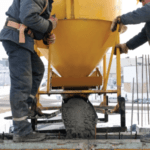A curing blanket is a great tool for those who run construction sites during cold weather. While a curing blanket is generally used for curing concrete, many construction companies and other industrial businesses have found additional applications. Here are some of the most popular:
Keeping Concrete Warm During Curing
The most popular application of a curing blanket is what the product was originally invented for—protecting the curing process of concrete in cold temperatures. The curing blanket is typically used at the final stages of concrete curing when the temperature of the concrete is important to achieve maximum strength. Curing blankets can be set at a particular temperature for optimal curing. The blankets have the ability to distribute the heat evenly and efficiently.
Warming Pipes in Winter
A frozen pipe can be big trouble. If the problem is not taken care of quickly, it can cause damage to the pipe and the building. Using a curing blanket to warm pipes in low temperatures will keep water flowing and prevent water from freezing in the pipe. Multiple blankets can be used to insulate the length of the pipe.
Temperature Control for Industrial Liquids
If you have industrial liquids such as propane that need to be kept or utilized outdoors, a curing blanket can easily help maintain an optimum temperature so that the liquid has an effective vaporization rate. It can also be used for a variety of other liquids that are best stored at a constant temperature, whether outdoors or inside a building with varying temperature.
Heating Equipment and Tools on Site
Working in the winter can be tough, especially in areas with low temperatures. Cold tools, scaffolding, and other supplies can be difficult or even dangerous to use. Storing supplies and equipment under a curing blanket will help keep them warm, usable, and comfortable when you show up on site each day.
Ice Melt and Prevention
A curing blanket can be used to melt ice and snow from a particular area, or to prevent snow and ice buildup on a particular spot. This can be useful when you want to prepare an area for work the next day. It can also be used to keep snow and ice from forming on tools and supplies left outdoors.
Every construction job has its own challenges, and there are many ways a curing blanket can help. Powerblanket can turn around custom solutions in as little as 14 business days so you can get on with the job.
Frequently Asked Questions
When should you use concrete blankets?
Concrete blankets should be used after the concrete has been laid and finished, and once the bleed water has evaporated, to stabilize the temperature and ensure proper curing, especially in cold weather conditions.
What can I use instead of a concrete blanket?
Instead of a concrete blanket, you can use alternative methods like spray-on concrete sealers, but these may not provide the same level of temperature control and protection against cold weather as concrete blankets.
How much do concrete blankets help?
Concrete blankets significantly aid in the curing process by maintaining optimal temperatures, which is crucial for the strength and durability of concrete, especially when temperatures drop below 50°F.
Will concrete blankets keep the ground from freezing?
Yes, concrete blankets can prevent ground freezing by insulating the area, making them useful for maintaining workable conditions on construction sites during cold weather.
When you need a custom temperature control solution, Powerblanket is the company to call. With over 30 years of experience, we can solve any heating dilemma you have.




